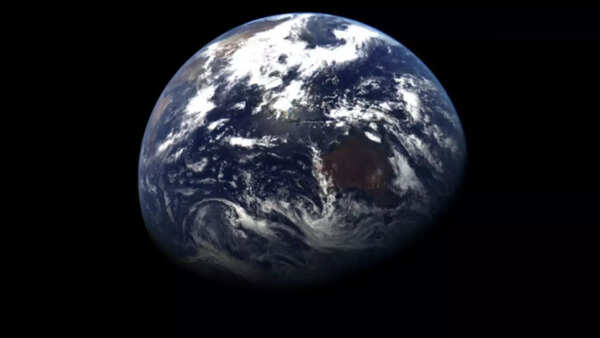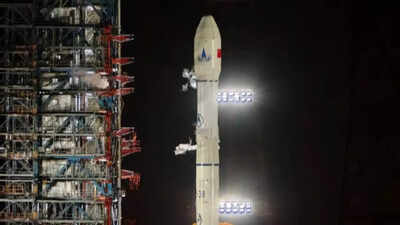China’s Tianwen-2 probe has officially begun its deep space mission by capturing a stunning image of Earth and the Moon from 590,000 kilometers away. Released by the China National Space Administration (CNSA) on July 1, the image symbolises the start of a decade-long journey to explore a near-Earth asteroid and a distant comet. Launched on May 29, Tianwen-2 will collect samples from asteroid Kamo’oalewa by 2027 and later investigate comet 311P/PANSTARRS. This dual-target mission marks a significant step forward for China’s space program, aiming to unlock key secrets about the origin of the Moon, water, and life.
Tianwen-2 probe: Earth-Moon images from deep space released by CNSA
The stunning photo was taken on May 30, 2025, when Tianwen-2 was nearly 590,000 kilometers away from Earth. The picture beautifully frames Earth and its natural satellite, the Moon, together in the vast darkness of space. This image was captured using the spacecraft’s narrow-field-of-view navigation sensor, an instrument designed to help the spacecraft maintain its orientation and enable precise autonomous navigation.This camera plays a critical role in guiding Tianwen-2 through deep space, allowing it to operate independently from ground control while maintaining stability during its long voyage.

Source: CNSA

Source: CNSA
Tianwen-2 marks milestone with over 12 million km travelled since May 29 launch
As of July 1, 2025, CNSA reports that Tianwen-2 is operating smoothly. As reported, the Tianwen-2 probe has been in orbit for 33 days with a distance of 12 million kilometres since its May 29 launch from the Xichang Satellite Launch Center aboard a Long March 3B rocket. Its successful performance in this early stage builds confidence in its ability to complete its complex multi-target mission.This probe is part of China’s broader space strategy to expand its scientific reach beyond the Moon and Mars, pushing boundaries into asteroid and comet exploration—domains previously dominated by NASA, ESA, and JAXA.
Tianwen-2 heads toward Kamo’oalewa; a mysterious near-Earth asteroid
Tianwen-2 is heading toward Kamo’oalewa, a small near-Earth asteroid that orbits the Sun in a path similar to Earth’s. What makes this asteroid particularly intriguing is the hypothesis that it might be a fragment of the Moon, dislodged by a massive impact event in the distant past.Upon arrival in 2026, the spacecraft will conduct detailed investigations, including:
- Surface imaging and mapping
- Material composition analysis
- Landing and sample collection
The samples will then be returned to Earth by 2027, providing researchers with rare, untouched material from a near-Earth object—potentially from the Moon’s ancient past.
Tianwen-2 to explore mysterious comet after asteroid sample return
Tianwen-2’s mission doesn’t end after the asteroid sample returns. It will be re-tasked to study the comet 311P/PANSTARRS, known for its active tail and mysterious dust ejection events. This phase of the mission could begin shortly after the asteroid visit and will involve:
- Close flybys of the comet’s nucleus
- Observations of gas and dust activity
- Analysis of chemical composition
Scientists hope this exploration could provide vital clues about the origin of Earth’s water and organic molecules, helping to answer one of science’s oldest questions—how life-supporting ingredients arrived on our planet.
Tianwen-2 sets a new standard with 10-year asteroid-to-comet space voyage
According to The Astronomy Magazine, the Tianwen-2 mission is planned to last more than 10 years, making it one of the longest and most scientifically rich deep-space missions in China’s history. Its dual-phase nature—first targeting an asteroid, then a comet—requires exceptional engineering and mission planning.This strategy mirrors the complexity and ambition of missions like NASA’s OSIRIS-REx and ESA’s Rosetta, but with a uniquely Chinese twist: combining asteroid sample return and comet observation into a single, seamless voyage.Also Read | NASA alert! 120-foot airplane-sized asteroid 2025 MM to make closest flyby on Earth today; should we be concerned


